Public transport in the Netherlands is some of the best in the world.
With huge costs to own cars, it’s no surprise both cycling and public transport thrive so well here.
But we imagine it can be intimidating to learn how to navigate (pun intended) this world of trains, trams, buses, and metros.
So, here, our travelling friends, is the complete guide to public transport in the Netherlands. 🚝
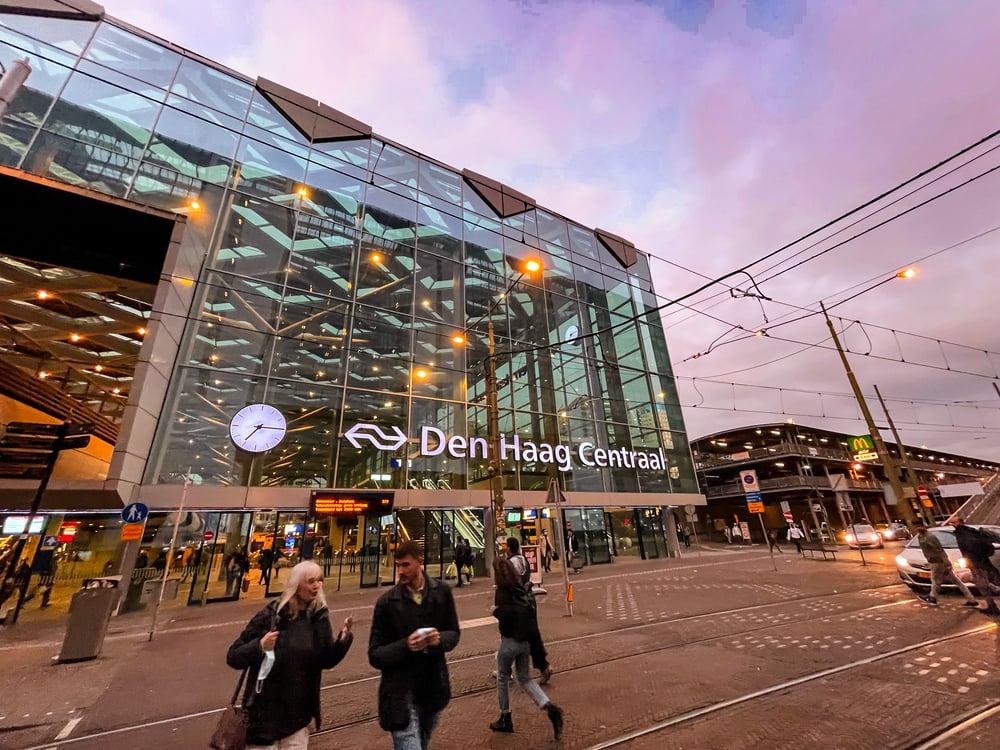
- 💸 Paying for public transport in the Netherlands: OV cards (OV Chipkaarten) or OVpay
- 📱 Apps for public transport in the Netherlands
- 🚀 The main types of public transport in the Netherlands
- 🚲 Other types of transport in the Netherlands
- Travel tickets and passes for the Netherlands
- ❓ Public transport in the Netherlands: frequently asked questions
💸 Paying for public transport in the Netherlands: OV cards (OV Chipkaarten) or OVpay
While public transport is considerably cheaper than owning a car in the Netherlands, it’s not free (unless you’re an eligible Dutch student).
If you plan on living in the Netherlands long-term, investing in an OV card (OV chipkaart) will likely save you some money and provide convenience when travelling around the country.
There are two types of OV cards: anonymous and personal.
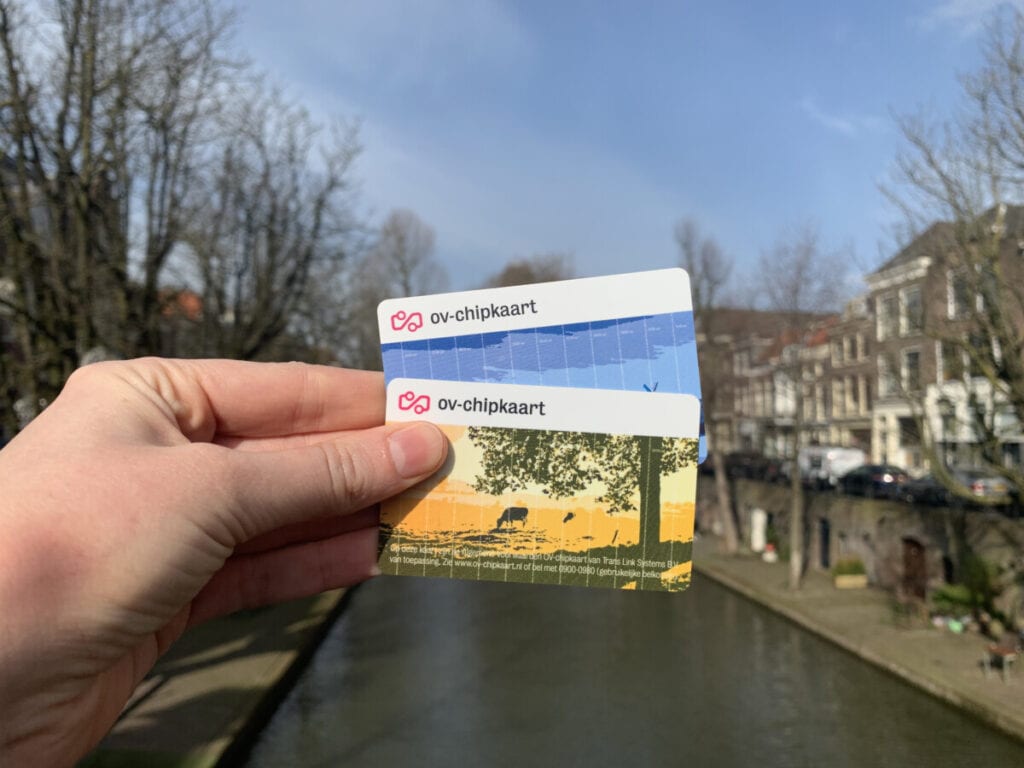
Anonymous OV Card (Anonieme OV-chipkaart)
If you’re on a short-term holiday, only travel by public transport on occasion or don’t want to share your personal details, a blue anonymous OV card might be the one for you.
With an anonymous OV card, you can share the card with other people (just not on the same trip), so they’re perfect to keep on hand for visitors. You can purchase one at stations, various supermarkets, and OV shops.
Every time you run out of money, you’ll have to manually top up your anonymous OV card. You can refill it by:
- using ticket machines or at an OV service shop in most train and metro stations, inside trams and buses.
- topping up at an OV point inside bigger supermarket branches using your ATM card.
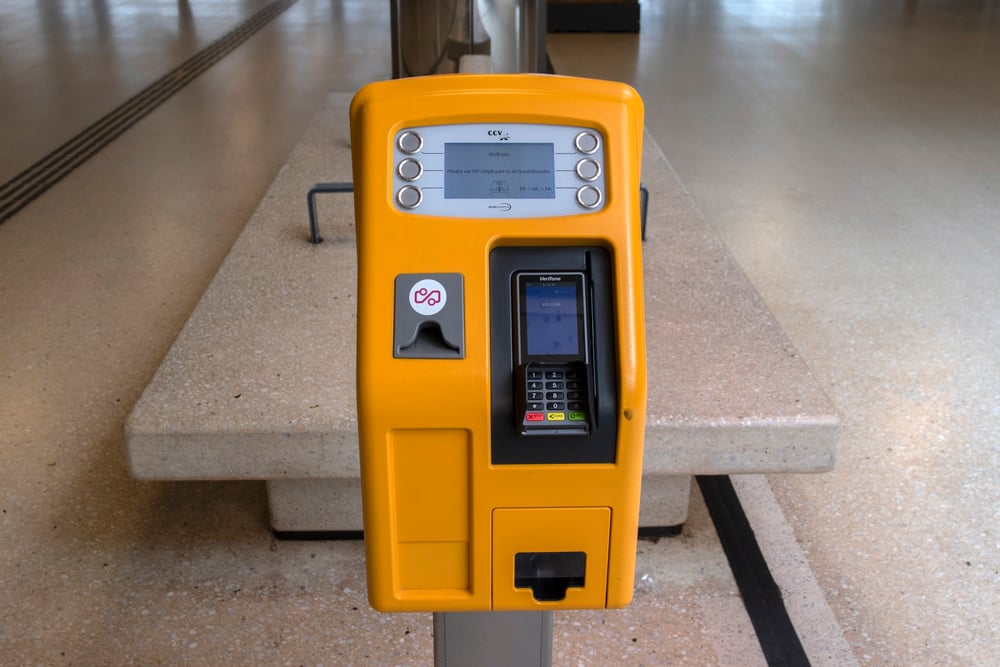
However, beware: regardless of where you top up your card, you may need to use a Maestro card, credit cards often don’t work in the Netherlands! ❌
Since this card type is anonymous, you can’t apply any discounts, and if you lose the card, you can’t get a credit refund on the money you lose. Helaas! (What a shame!)
Personal OV Card (Persoonlijke OV-chipkaart)
If you think you’ll be travelling with public transport in the Netherlands more frequently, a yellow personal OV card is the way to go.
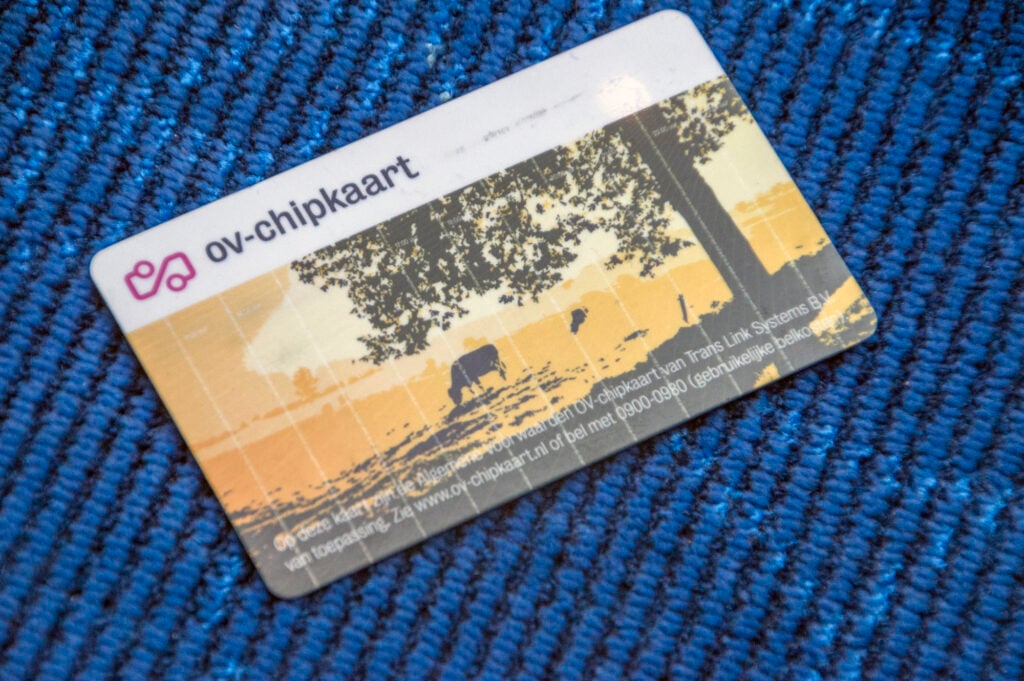
Having a personal OV card has some great perks, including adding special discounts or travel deals, automatic reloading when you run out of money, and the card can be blocked and reissued if lost or stolen.
Tip: You can get a 40% discount on your travel costs or pay for unlimited daily or monthly travel during off-peak hours using a personal OV card — it’s even possible to share your discount with travellers who use an anonymous OV card. That’s too much korting (savings) to pass up!
It costs €7.50 to order the card via ovchipkaart.nl, but you’ll quickly see that money pays for itself in no time when you use those sweet discounts. 😍
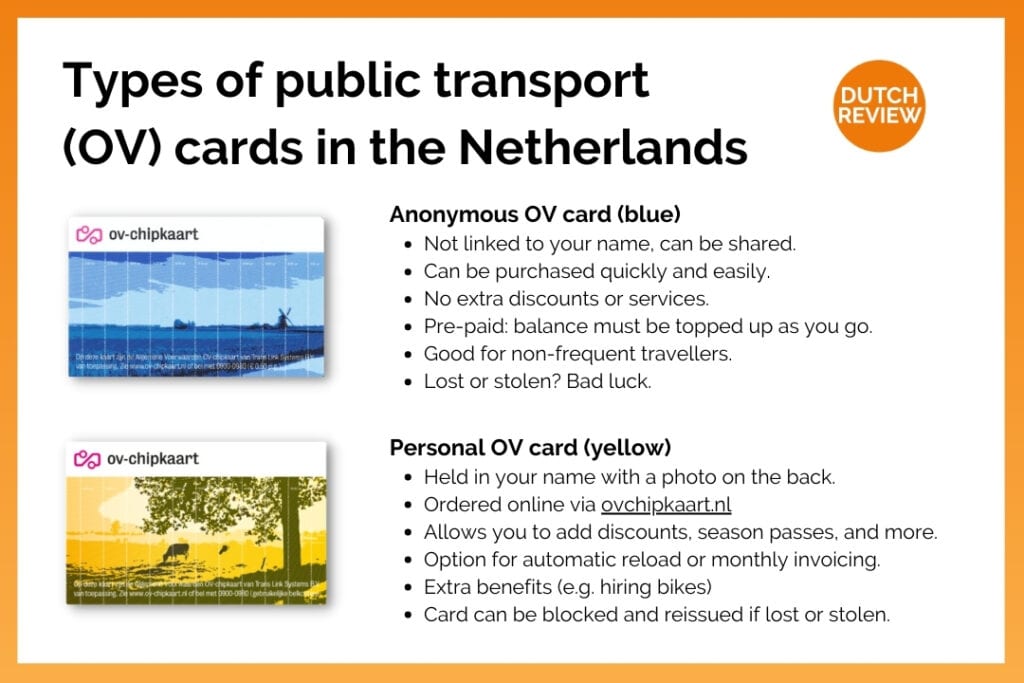
OVpay
Alternatively, you can opt for checking in and out using your smartphone, debit card, or wearable on public transport.
This is particularly appealing for short-term visitors, as you’ll only need your phone to travel nationwide by train, tram or metro! 📳
📱 Apps for public transport in the Netherlands
There are apps for everything nowadays, and public transport in the Netherlands isn’t an exception. There are a few options if you want a little help travelling around the country.
9292
The essential travel app helps you plan your journey via public transport anywhere in the Netherlands, at any time, using all modes of transport you want.
The app lets you pick individual addresses and postcodes, and you can input any station or stops you want to travel through. 9292 also offers accessible travel options like adding extra transfer times and planning journeys for wheelchair users. 🦽

But that’s not all! You can store e-tickets via the 9292 mobile apps and save particular travel routes for future reference. They have a section for expected and unexpected interruptions and services everywhere.
NS
With the same name as the Dutch Railway system company, the NS app is similar to 9292’s services — but only covers train journeys. 🚄
The NS app is stocked with comprehensive train schedules and a train journey planner. The app also provides live updates on train delays, disruptions, and planned maintenance so travellers can check what’s working and what isn’t.
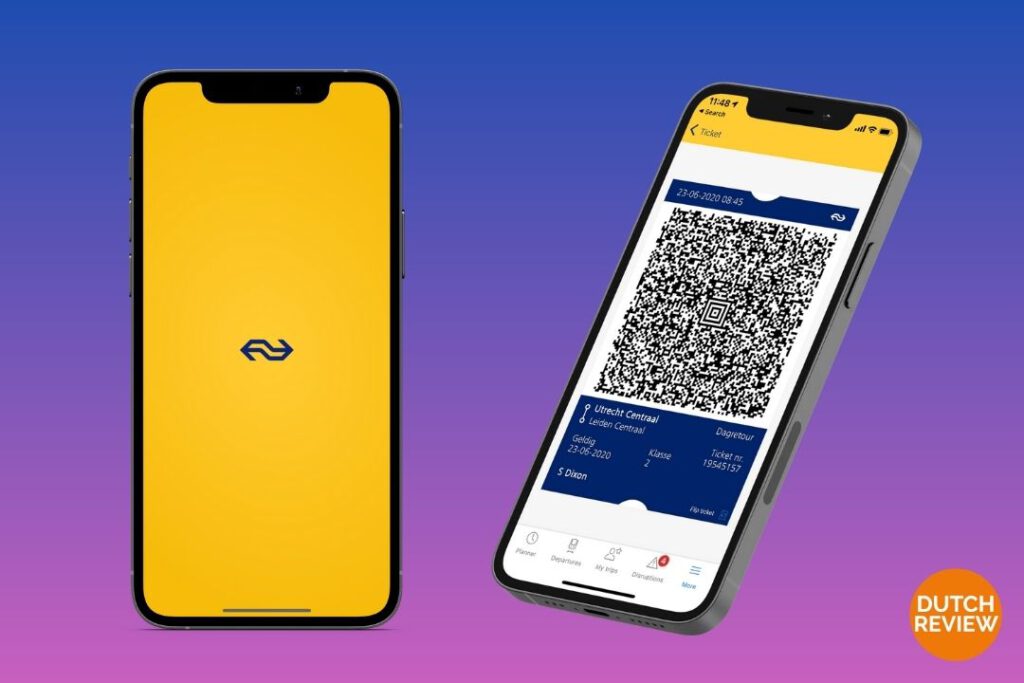
Like 9292, you can also easily store e-tickets and plan your train journeys. Leuk!
Google Maps
A staple app for most people, Google Maps has an option to check travel routes via public transport.📍
Google Maps isn’t as comprehensive as 9292 or NS, but if you’re only planning on travelling around the Netherlands for a short time, Google Maps will do the job just fine.
🚀 The main types of public transport in the Netherlands
Ah yes, the part you’re probably here for (and we hope you’re not standing on a cold train platform while you read this). Public transport in the Netherlands has many forms but can have huge differences.
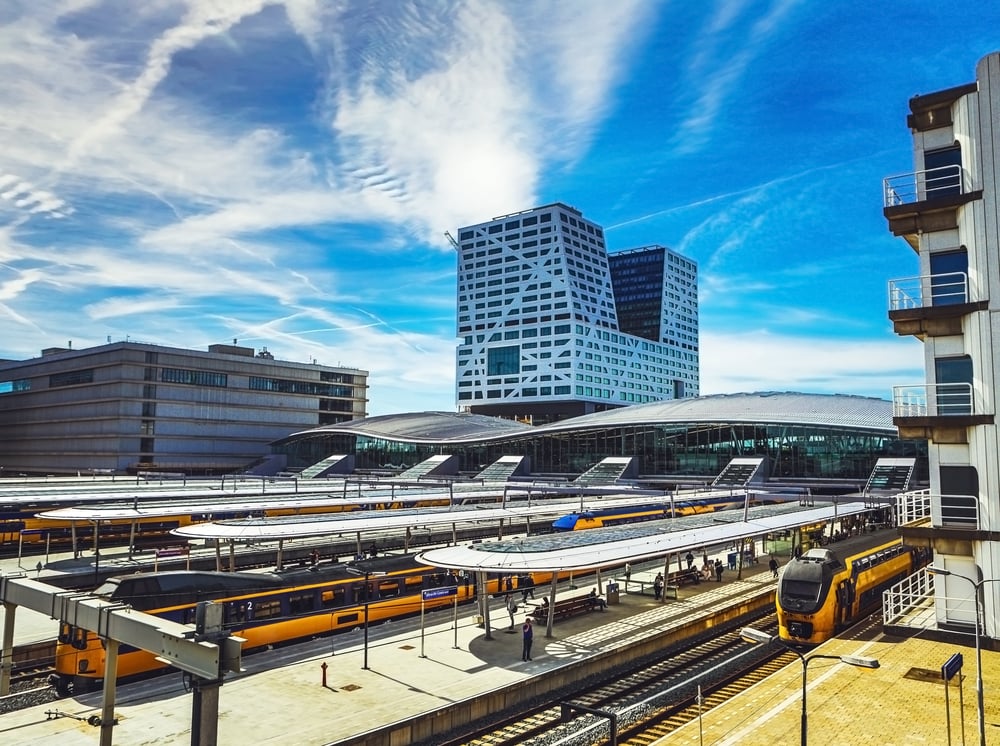
Here’s how to best navigate the trains, trams, metros, buses, and ferries in the Netherlands. 🗺
Travelling by train in the Netherlands
Travelling by train is a basic form of public transport in the Netherlands, especially if you plan to take day trips to other Dutch cities.
There are a couple of things to know if you’re going to hop on and off one of these metal tubes. 💨
First- and second-class cars
All trains are divided into first- and second-class cars, which you can see by which number is plastered on the outside of the car or the small plaques inside. 🥇🥈
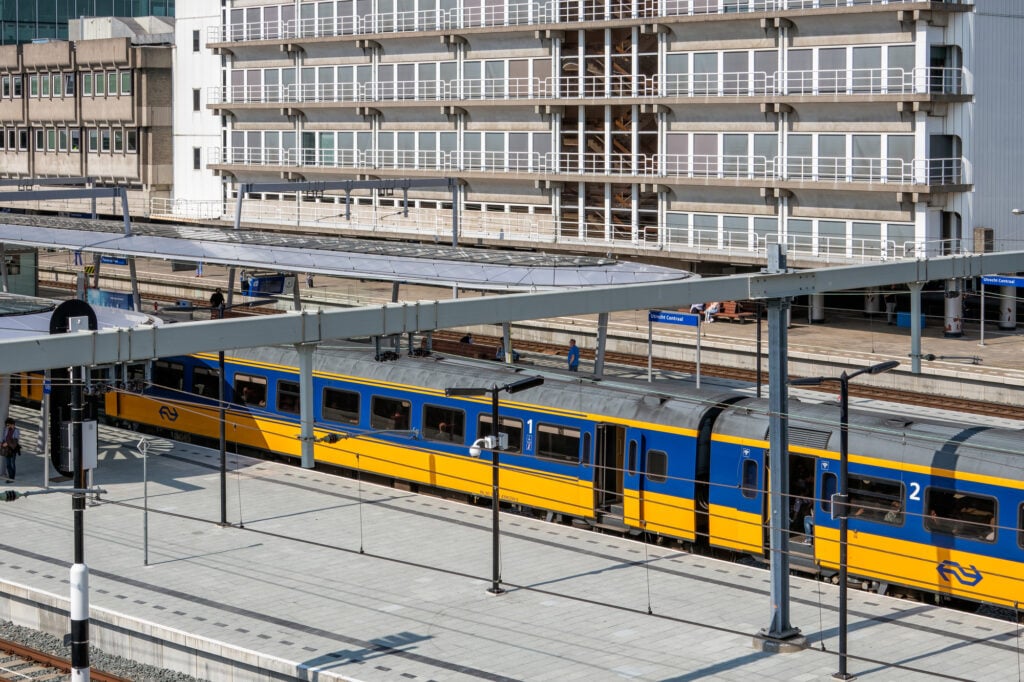
The difference? First-class seats and cars are generally cleaner, more expensive, and more spacious than second-class cars. First-class seating areas also have extra luxuries like comfier chairs and footrests. 💺
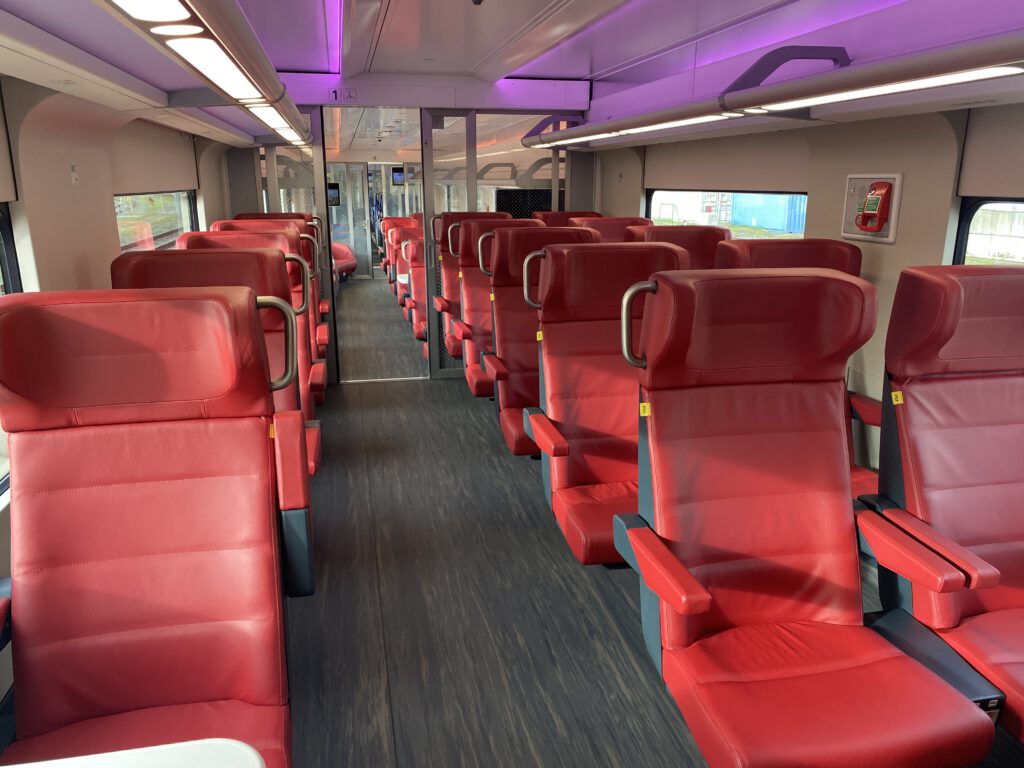
Although the cleanliness levels may vary, you’re not really missing out on anything if you’re travelling in the second-class car of a train.
You’ll be able to choose whether you want to sit in first or second-class and compare prices when you’re purchasing your ticket. If you’re using an OV card, you can automatically travel in the second-class cars of any NS train and can upgrade via the app if you want to move into first class.
Warning: Thinking about investing in first-class train travel? It’s possible to change which train class you’re paying for through the NS website, but you can only add personal discounts or travel plans to a personal OV card!
Types of trains in the Netherlands
There are three main types of trains in the Netherlands:
- Sprinters
- Intercities
- Intercity Direct
Sprinter trains
Don’t let the name fool you: the Sprinter is the slowest type of Dutch train (extremely misleading, if you ask us.)
Sprinters are smaller and slower trains. They usually connect big cities together but also travel through and stop at all the smaller towns and villages. 🐌
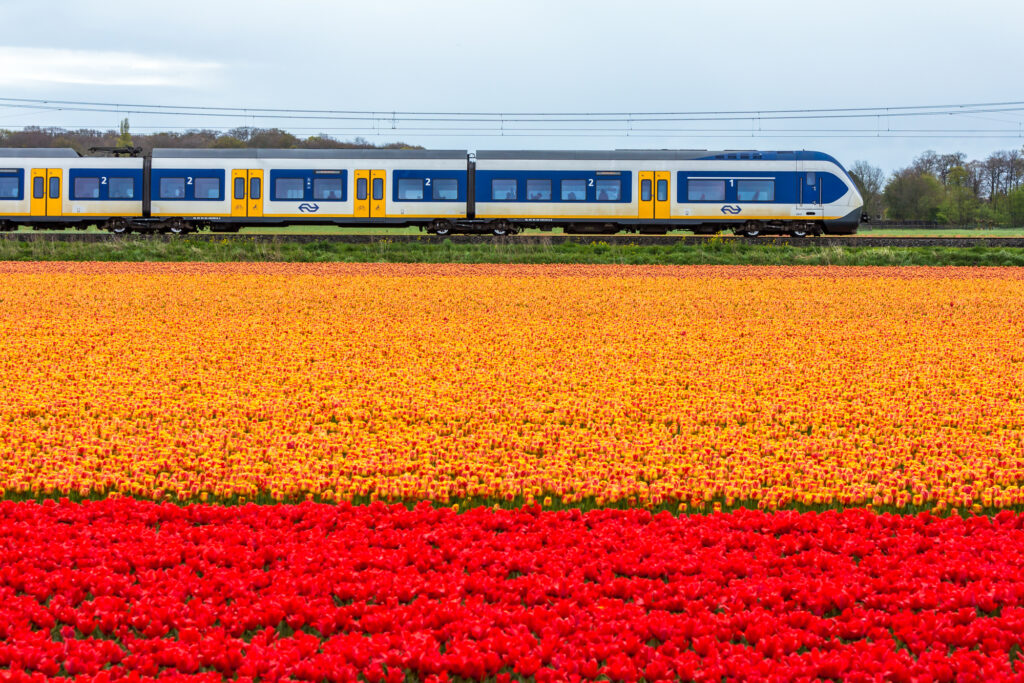
Sprinter trains tend to have frequent stops and relatively short travel times between stations, with travel times between stations ranging from three minutes up to 11 minutes.
A Sprinter train is a good choice if you need to get to a smaller village, for example, if you are travelling from Amsterdam Central Station to Woerden or The Hague Holland Spoor to Schiedam.
Generally, sprinter trains don’t have WiFi or toilets since they’re made for shorter train journeys. However, newer sprinter models will have toilets in them (good news if you have a small bladder). 😅
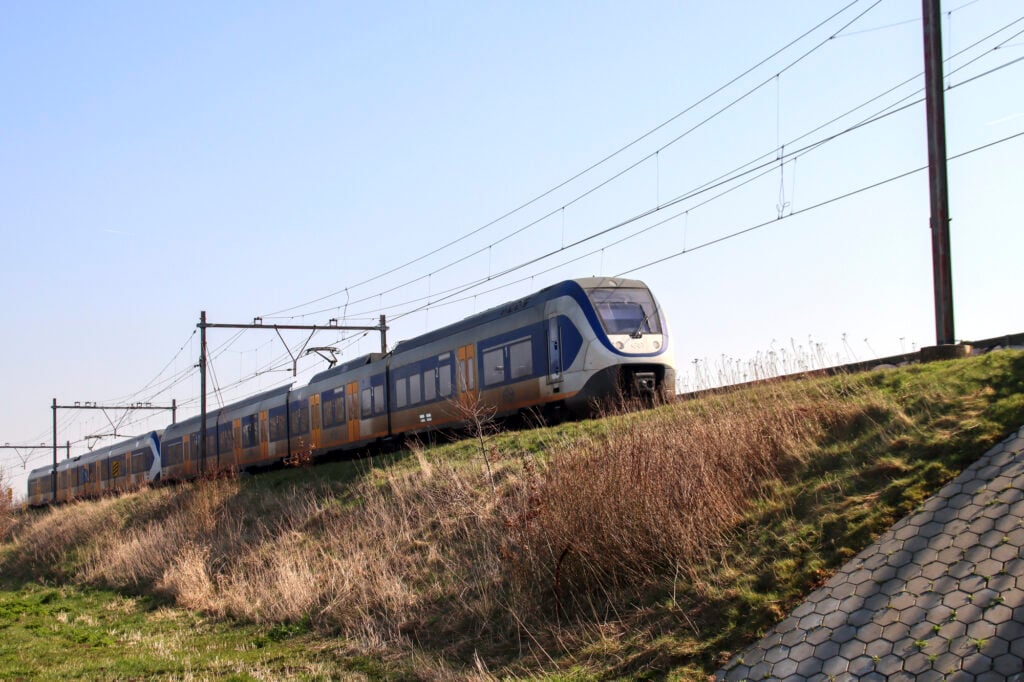
You can check whether you’re taking an Intercity or Sprinter train and if there is a toilet at your station using the Reisplanner Xtra app.
Intercity trains
Intercity trains travel between the larger cities in the Netherlands. They are bigger, faster, and tend to make fewer stops.

Intercities also have longer routes and travel times between stations, ranging from five minutes to 18 minutes between stops. 🚅
Intercity Direct trains
Intercity Direct trains are similar to the regular ‘ol Intercity trains — the main difference is in the routes they take. 🚄
These trains only travel directly between Amsterdam Centraal, Rotterdam Centraal, Schiphol Airport, and Breda.

They save a lot of time because they don’t stop at other stations and travel very fast on the tracks. 🏃🏻
Take a look at these train travel times:
- Non-Intercity Direct journey from Schipol Airport to Breda: 1 hour and 21 minutes
- Non-Intercity Direct journey from Amsterdam to Rotterdam: 1 hour and 6 minutes
In comparison to:
- Intercity Direct journey from Schiphol Airport to Breda: 39 minutes
- Intercity Direct journey from Amsterdam to Rotterdam: 25 minutes.
Be warned! You have to pay a small surcharge to use this train, about €3 each way. You can pay this extra fee by scanning your OV card on a red and grey supplement machine on the platforms where you take an Intercity direct train.
Types of train tickets
If you have an OV card, personal or not, just tap your card on the readers on the platform barriers, which serves as your “train ticket”. 🎫
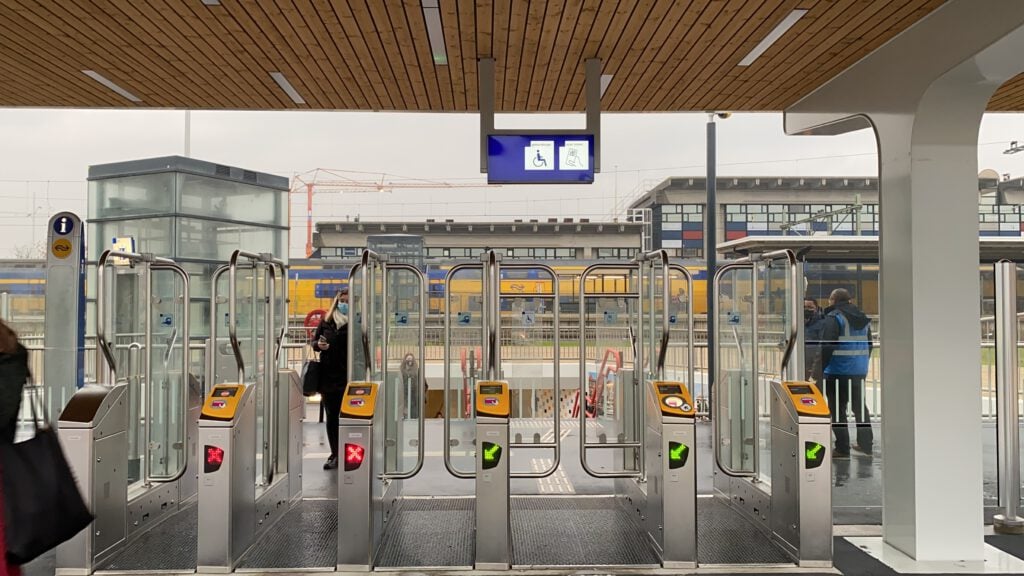
You need to have at least €20 to be let in through platform barriers at any train station, but if your OV card has under €20 and the automatic reload option, you will be let through (yet another reason a personal OV card is the way to go).
If you don’t have an OV card, you’ll need to buy a ticket. Yet, figuring out which train ticket to buy can be overwhelming.
NS sells individual train tickets (for one-time journeys like a day trip) and season train tickets (for passengers who will travel by train on a daily or weekly basis).
Individual tickets
These ticket types are for one-off train travels or if you need to do a big trip with other people, your dog, or your bicycle.
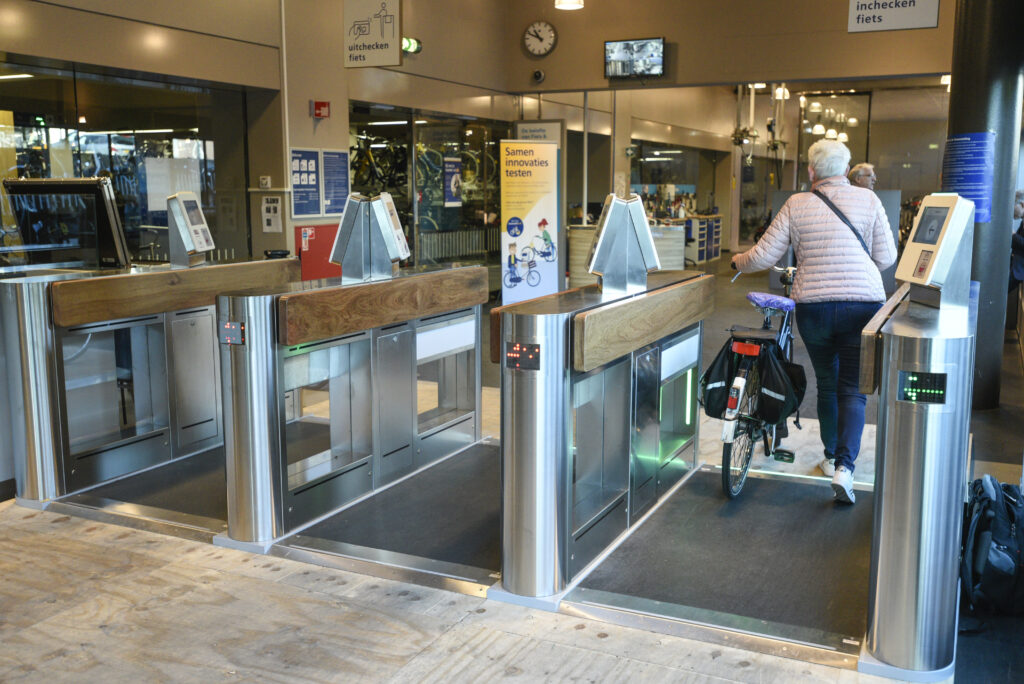
You can expect train tickets to cost a few euros for a short round trip and up to around €20 one way to go across the country. It really depends on which stations and which city you plan your journey from.
Season tickets
Season tickets are more like a train subscription than single tickets. If you’re looking for longer-term travel tickets with hefty discounts travel tickets, season tickets might be what you’re looking for!
For example, if you have to commute to your job in a different city, discounted train travel is a must-have in the Netherlands.
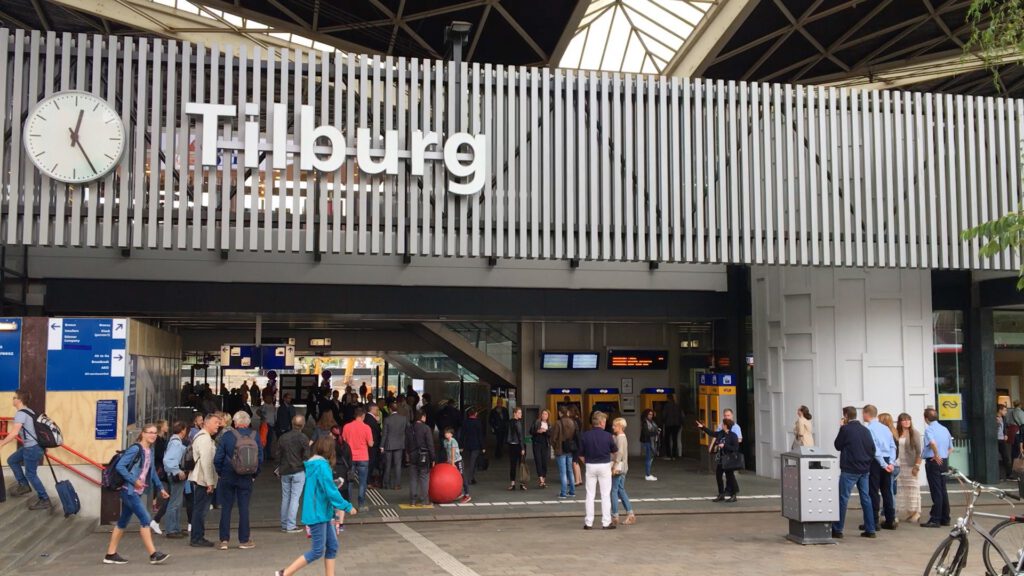
There are different types of season tickets for different needs, such as free train travel on the weekend, discounts during off-peak and peak hours, and the possibility of discounted travel with other people travelling with you.
Tip: In general, you’ll find that train tickets cost less money if you buy them online and travel during off-peak hours (before 6:30 AM, between 9 AM and 4 PM, and after 6:30 PM).
If you need to travel during peak hours (between 6:30 AM and 9 AM and between 4 PM and 6:30 PM), you can only get discounts with select season tickets.
How to buy train tickets in the Netherlands
So you know how trains work and which train ticket you want to buy — but how do you buy a ticket, say, for trains to Amsterdam? There are three main ways:
- Purchasing tickets online
- Purchasing tickets via the NS app
- Purchasing tickets at a train station or at an OV shop
If you feel more laid back and want to see where the road (or tracks) take you, you can buy tickets at most train stations, either at a ticket machine or at one of the OV service shops.

If you’re the kind of person who has everything planned in an itinerary down to the minute and the hour, you can also buy your train tickets in advance via the NS website.
Plus, if you log in to the website, you can immediately save your tickets on your phone via the NS app. It definitely makes travel planning easier!
Good to know: While you don’t necessarily have to buy your tickets months in advance for your train journey, you must have a valid ticket the moment you step on the train. That is to say, you can’t buy a train ticket while you’re on the train already.
How to check Dutch train schedules
Types of trains? ✅
Types of tickets? ✅
Where to buy tickets? ✅.
Knowing where to see that trusty train schedule? Well, that’s important too!
You can board the train from inside the main station hall. Trains to Amsterdam and other cities like Rotterdam and The Hague run really frequently, usually around every 10 to 15 minutes.
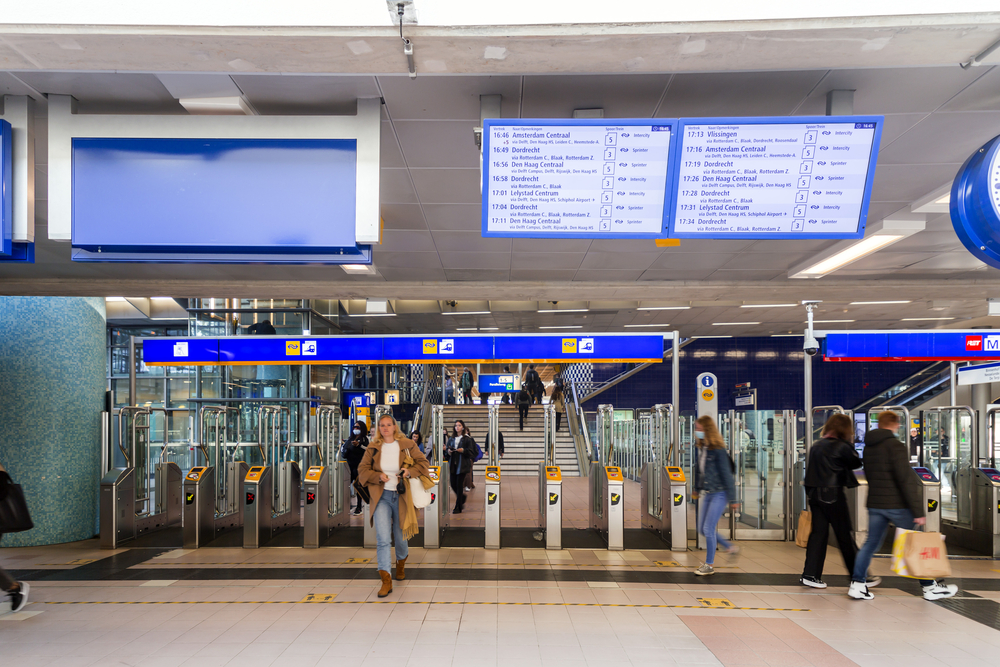
There are a few main ways to check the train schedules:
- If you’re a seasoned passenger on public transport in the Netherlands, it’s common to just show up at the station and find out what the next train is by looking at one of the info boards.
- You can use public transport apps like NS, 9292, and Google Maps.
- You can check the full table of train routes and schedules on the train platform itself. These tables show you every stop the train takes and what time it departs from the station you’re standing in every hour for every day of the week. Handig! (Handy!)
The train timetables are usually available in Dutch and English, so it’s easy for non-native Dutch speakers to navigate their way around the rails.
Travelling by metro in the Netherlands
Only Amsterdam, Rotterdam, and parts of The Hague have metro lines. 🚉
Amsterdam and Rotterdam have metro lines that run through the cities and surrounding areas. Rotterdam also has a direct metro that runs to The Hague Central Station.
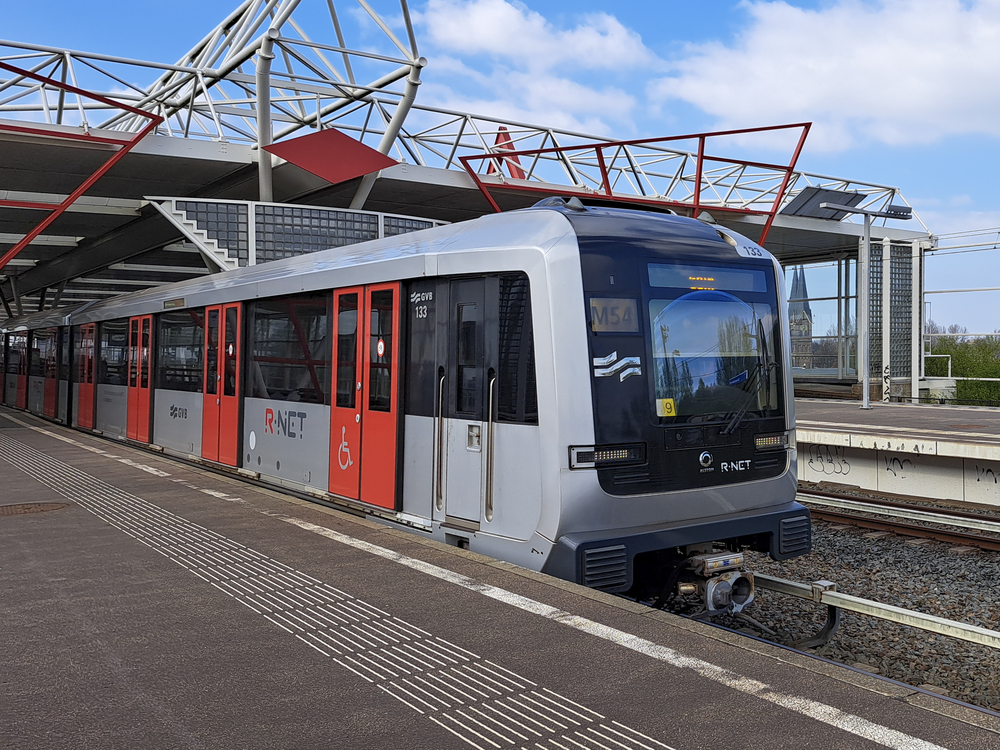
To board a Dutch metro is really easy: just scan your OV card or ticket at the platform barriers and walk on through! Remember to scan out at the end.
Types of metro tickets
There are two main types of metro tickets: one-hour tickets and day tickets. These tickets let you travel anywhere, regardless of distance. Your ticket becomes validated when you first check-in for a one-hour ticket or 24 hours for a day ticket. ⏱
Amsterdam offers a one-hour ticket and tickets for up to seven days of travelling using the GVB (Municipal Transport Company). The company operates metros, trams, buses, and ferries in the metropolitan area of Amsterdam.
Rotterdam is slightly different — the RET (Rotterdam Electric Tram) company only offers a two-hour ticket or a day ticket for one day.
The great part about travelling with an hourly ticket or a day ticket is that you can use them to travel on any public transport (trams, metros, buses) within Amsterdam or Rotterdam.
Keep in mind: You cannot use these hour or day tickets to travel on the trains. They are only available with trams, metros, and buses within the respective city.
How to buy metro tickets in the Netherlands
You can get your metro tickets in a few ways:
- Check into the barriers using your OV card or OVpay
- Order your tickets online through the 9292 app, the RET website for Rotterdam and the GVB website for Amsterdam.
- Buy metro tickets using the ticket machines or at the OV service shop within the metro and train stations. Just remember to switch the language to English first! 🇬🇧
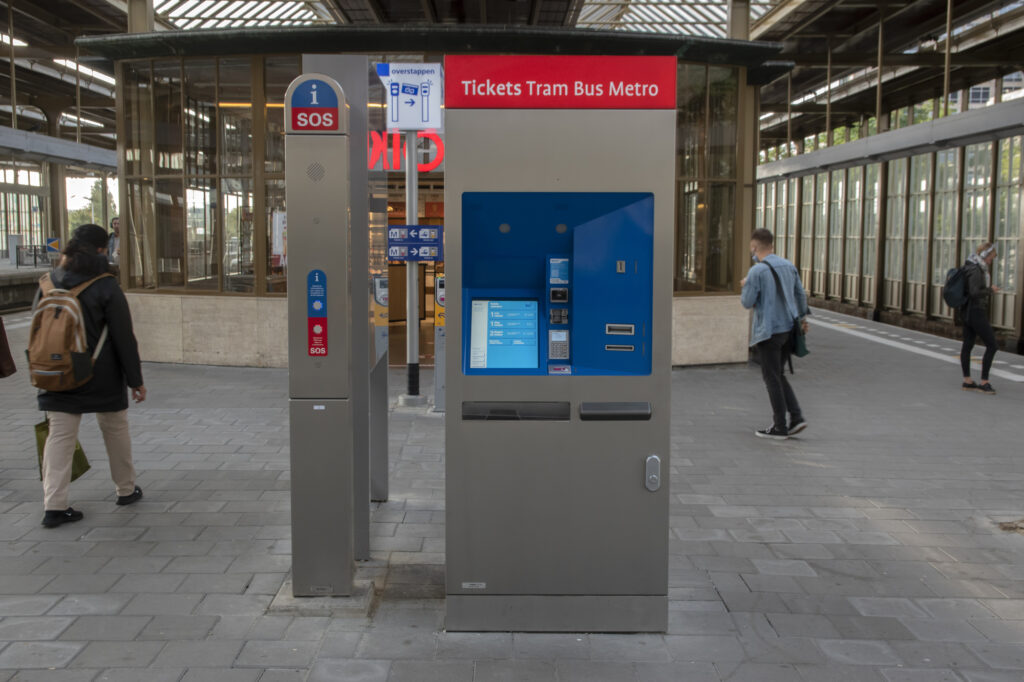
How to check Dutch metro schedules
Similar to buying tickets online, you can check the metro schedules using the apps or websites of 9292, RET, and GVB.
You can also use Google Maps, especially if you want to plan around specific locations, but this app isn’t the most accurate if you’re just going to use the metro to get back and forth places.
Google Maps allows you to look at several travel options, potentially using different forms of public transport. You can also save travel routes you might use frequently. 🗺
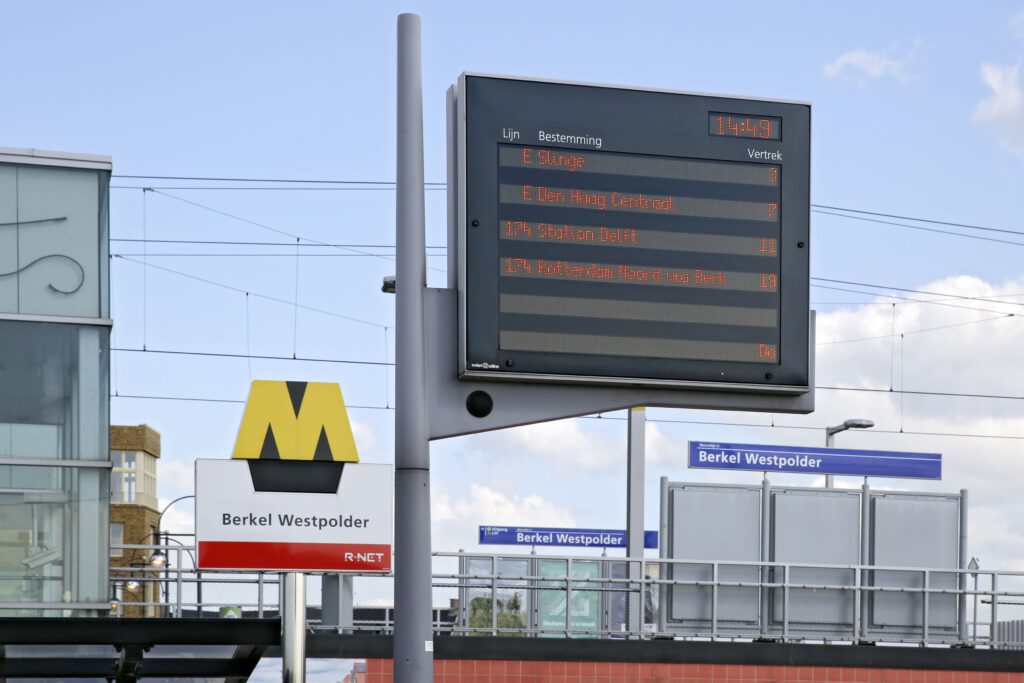
Travelling by bus in the Netherlands
Bus travel is probably the most common type of public transport within and around cities, towns, and villages. 🚌
Buses often travel within the city centre and outer parts of the city, but also on the highways to smaller towns and villages, especially those inaccessible by train, metro, or tram.
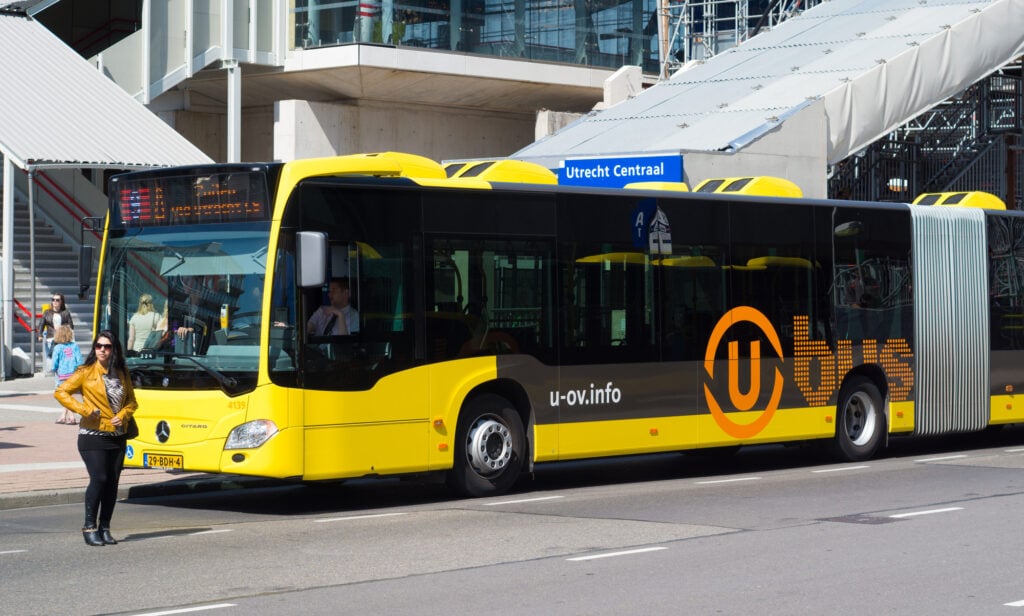
Many Dutch towns only have buses available for public transport because the towns are too small for metro and tram rails.
Types of bus tickets
In big cities like The Hague, Rotterdam, and Amsterdam, which have several types of public transport, you can often use one-hour tickets or day tickets to travel on buses as well as trams and metros. There are a few common types of tickets:
- Hour tickets (these can be for just an hour of travel to up to three hours of travel)
- Day tickets
- Checking in with your OV card or OVpay
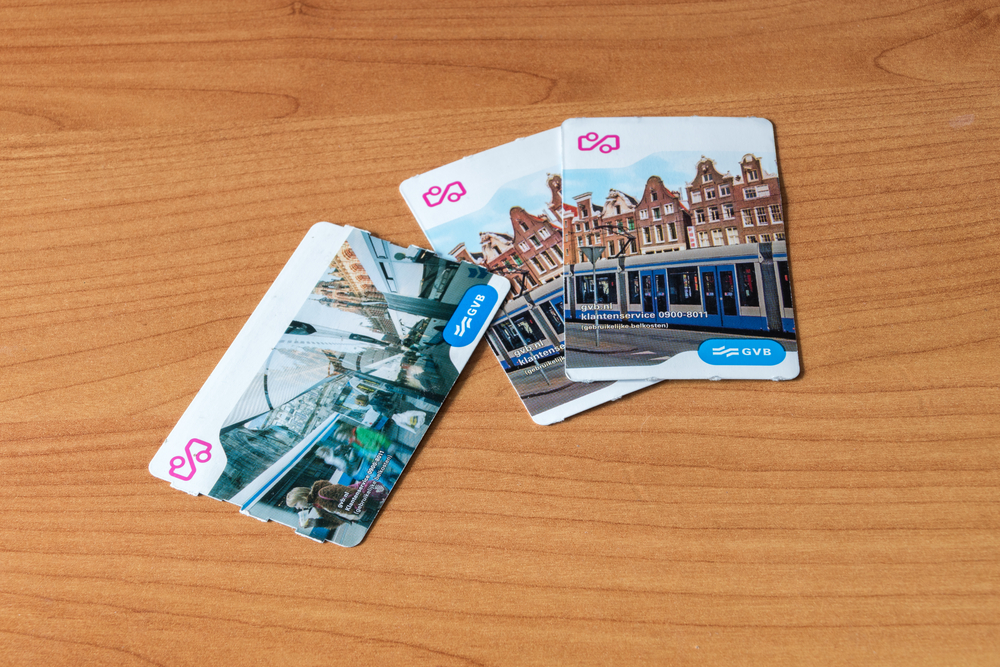
How to buy bus tickets in the Netherlands
Like metro tickets, there are a few ways to buy tickets for the bus:
- Check in and out of a bus using your OV card or OVpay.
- Order your tickets online via the public transport websites for The Hague, Rotterdam, and Amsterdam. You can also buy tickets via the 9292 app.
- Purchase a one-hour or day ticket for a bus at ticket machines or an OV service shop in major train stations and bus hubs in the Netherlands.
- Buy your ticket from the bus driver right when you board the bus. Bus drivers only accept card payments. Just remember you’ll need to use a debit card (not a credit card, Visa Debit card, or Debit Mastercard). 💳
It’s often possible to reload your card if you’re a few euros short too. Just ask the bus driver, and you can pay using the previous methods.
Keep in mind: Although a sort of unspoken rule, passengers need to enter at the front-most door of the bus and scan their OV card at the reader next to the bus driver unless they’re travelling with a baby stroller.
However, if you’re getting off the bus, you can only scan and leave through one of the rear exits of the bus (because passengers are presumably entering through the front). If you need to transfer buses, just tap your card to step off and tap it again on your next bus.
A similar rule applies to trams. Just make sure to pay attention to the stickers on the doors, or simply follow the locals!
How to check Dutch bus schedules
If you’re going with the flow and don’t have schedules in mind, bus stops have information about when the bus arrives and leaves at that given stop. 🚏

If you’re travelling specifically in one of those big cities, you can check bus schedules via Google Maps, the RET app (Rotterdam), the GVB app (Amsterdam), and the HTM app (The Hague).
In smaller cities, towns, and villages, it’s easiest to use 9292 since that includes travel routes for the whole country (which is also useful if you need to make transfers).
Tip: If you’re waiting at a bus stop, make sure to raise your hand clearly to signal the driver that you want the bus to stop. Otherwise, the driver might not realize you want to board and could drive past.
When you’re on the bus and approaching your stop, press one of the red “stop” buttons inside the bus. These buttons are located throughout the bus. This lets the driver know you want to get off at the next stop.
Travelling by tram in the Netherlands
These tubes on wheels are the slower, inner-city counterparts of metros that help everyone get around the city. Trams are generally found in bigger Dutch cities with street space to accommodate them.

Types of tram tickets
The two main types of tram tickets in the cities are hourly tickets or day tickets — similar to buses and metros; you can use these hour or day tickets across all types of public transport within that city. 🚋
For example, an hourly ticket in Rotterdam will let you make unlimited rides on the bus, metro, and tram within that hour.
How to buy tram tickets in the Netherlands
There are a few ways to buy a tram ticket in the Netherlands. You can:
- Tap your OV card or OVpay on the card readers when your board and disembark each tram.
- Purchase at a ticket machine or an OV service shop at a station or stop.
- Pay inside the tram from a ticket machine (The Hague), the tram conductor or the tourist booth (Rotterdam and Amsterdam).
- Purchase on the city’s public transport website. The Hague, Rotterdam, Amsterdam, and Utrecht have individual ticket-purchasing websites.
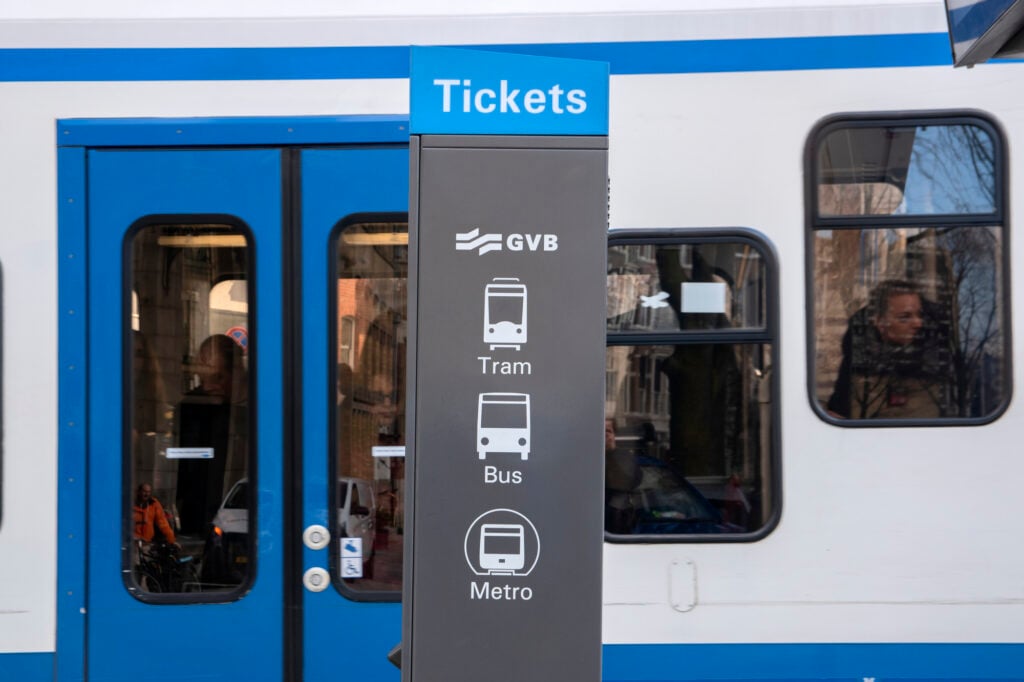
How to check Dutch tram schedules
If you’re travelling within a city, you can use their public transport apps to check when certain trams depart and arrive from their stops. This includes HTM (The Hague), RET (Rotterdam), and GVB (Amsterdam).
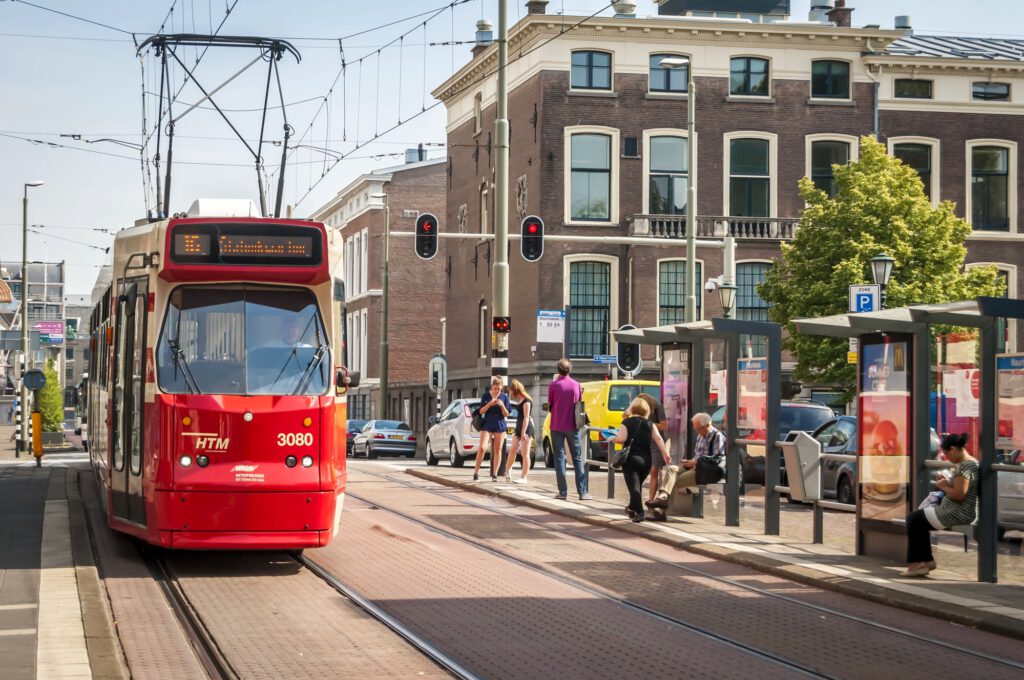
You can also check the schedules using 9292 or Google Maps, although Google Maps isn’t the most accurate. However, it’s useful to help you get directly to your destination once you’ve stepped off the tram.
Travelling by ferry in the Netherlands
Probably one of the rarer forms of public transport in the Netherlands, it’s also possible to travel by ferry in and around certain cities, towns, and villages. ⛴
This mode of Dutch public transport isn’t available everywhere. Ferries are mostly available in areas surrounded by a lot of water (cough, Amsterdam and Rotterdam, cough). 🏙
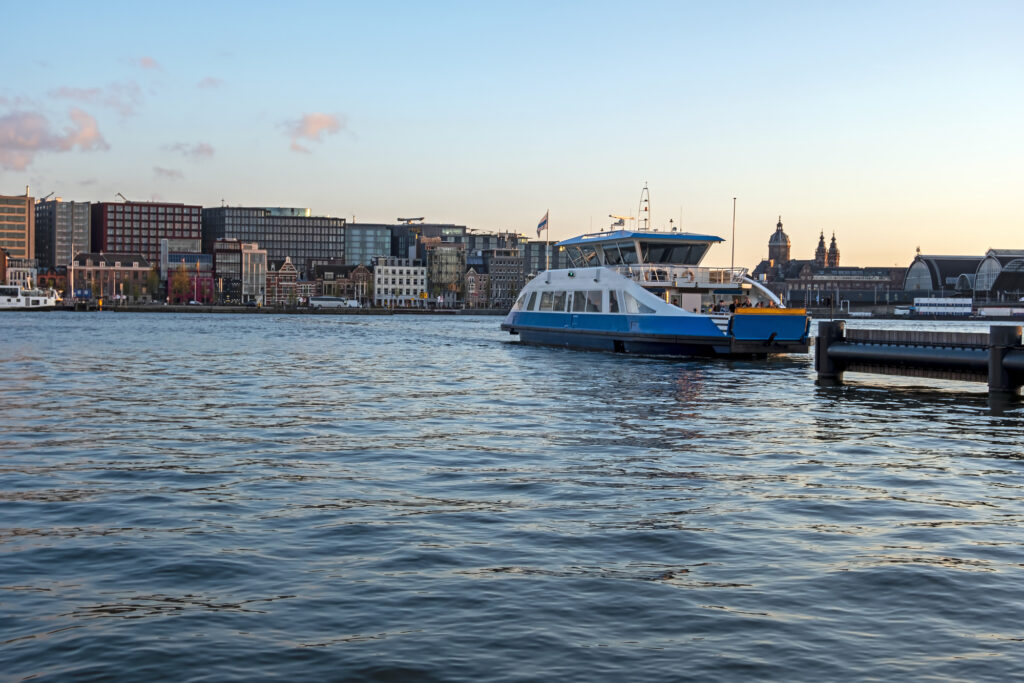
Many people like to visit the industrial area NDSM or the EYE Museum in Amsterdam or take the water taxi in Rotterdam to Kinderdijk’s famous windmills. Or even just to cruise across the water for fun!
Types of ferry tickets
For those lucky travellers in Amsterdam, you can travel on any of the ferries within the city for free! You don’t have to buy a ticket beforehand, and you can just step right on board before it leaves.
The GVB offers 10 different ferry lines within the city — so if you’re not in the mood for biking or walking across a bridge, you can take your bikes on the ferry! Just make sure to jump off and walk it on first.
As for Rotterdam, the Waterbus (that’s what the ferries are called) has four main types of tickets:
- OV card
- E-ticket
- Onboard ticket
- Waterbus day card
OV card
Like all forms of public transport in the Netherlands, you can pay for a ferry trip using your best friend, the OV card. Simply scan your card on the ferry’s OV readers, and you’re good to go!
E-ticket
If you’re into planning your journeys ahead, e-tickets are the way to go. Waterbus sells single, return, and day tickets. Perfect for any occasion!
Single and return tickets cost as low as €2, and day tickets start at €14.50. Ticket prices depend on your starting destination and point of departure, but you can check exactly how much tickets cost for your desired journey.
Onboard tickets
You can buy the same types of tickets as the e-ticket onboard the ferry itself. You can ask the ferry steward for information about which ticket suits your journey and easily pay using your ATM card (They usually don’t take cash or credit cards).
Waterbus day card
Waterbus day cards let you travel on all ferry lines for a whole day, as many times as you want!
You can buy one of these bad boys online, on the ferry, and in several retailers around the city (check out some of the tourist centres!)
The day cards cost €14.50 to buy online — a pretty good deal if you ask us!
How to check Dutch ferry schedules
Both Waterbus (for Rotterdam) and the GVB ferries have schedules that run at the same time each day. For certain holidays, you’ll have to check which days they run and which days they don’t.

You can also check for GVB ferry schedules on 9292. Waterbus is a private company, so they don’t have their schedules integrated with 9292.
🚲 Other types of transport in the Netherlands
In addition to the public transport options above, people in the Netherlands are also very keen on shared mobility — as part of sustainability initiatives and efforts, plenty of Dutch cities offer stylish, green ways to travel around. 🛵
READ MORE | Shared mobility in the Netherlands: the ultimate guide
Apart from your typical forms of public transport in the Netherlands, there are other modes of transport you might want to familiarise yourself with.
Bike rentals in the Netherlands
As a country that loves and treasures bicycles, the Netherlands does its best to make cycling accessible to everyone across the whole country!
Typically, Dutch residents will have their own bicycles (and even a second or third one, if they’re busy bikers), but there are plenty of places to rent bicycles for a few hours up to a few days. 🚲
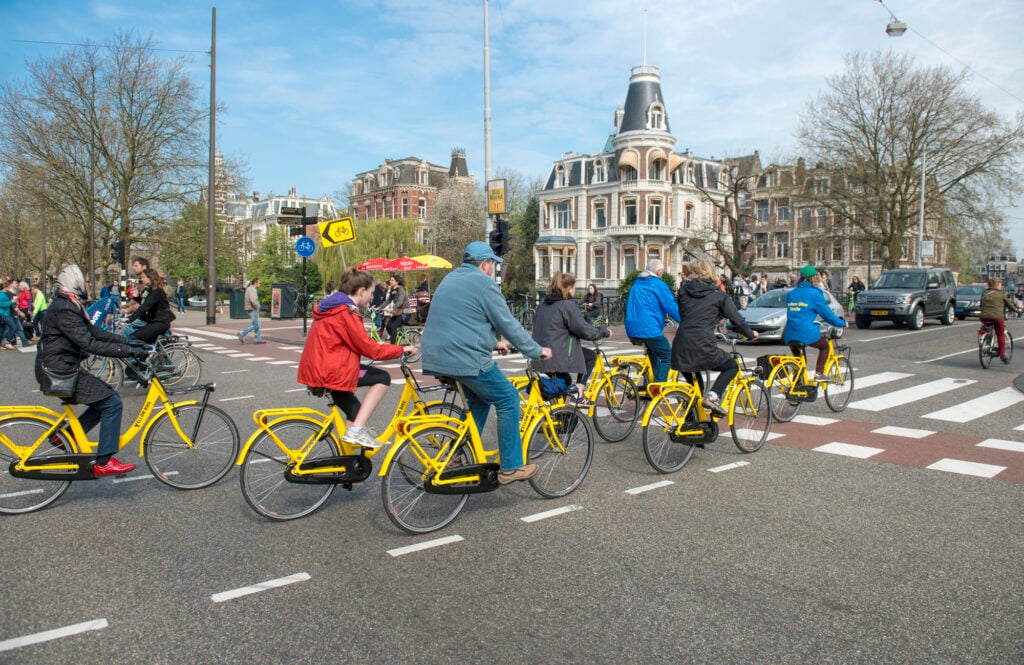
Given that it’s the tourism centre of the country, Amsterdam has PLENTY of bike rental places. You could check Google Maps, the Amsterdam municipal website, or even just walk around the city searching for a bike rental place.
READ MORE | How to rent a bike in Amsterdam in 2025: places, prices, and tips
Most major cities have a good variety of bike rental places. Most shops that sell bikes will offer repairs and bicycle rentals, so you won’t run into any trouble finding a place to rent!
Bike rental costs vary from place to place, but the average price falls between €15 and €20 per day. 💶
If you have a personal OV card, you can also rent an OV bicycle — a shared bike network. You can pick these up at most major train stations and select OV bike points. One perk about these OV bikes is that they only cost €4.65 to rent per 24-hour period.
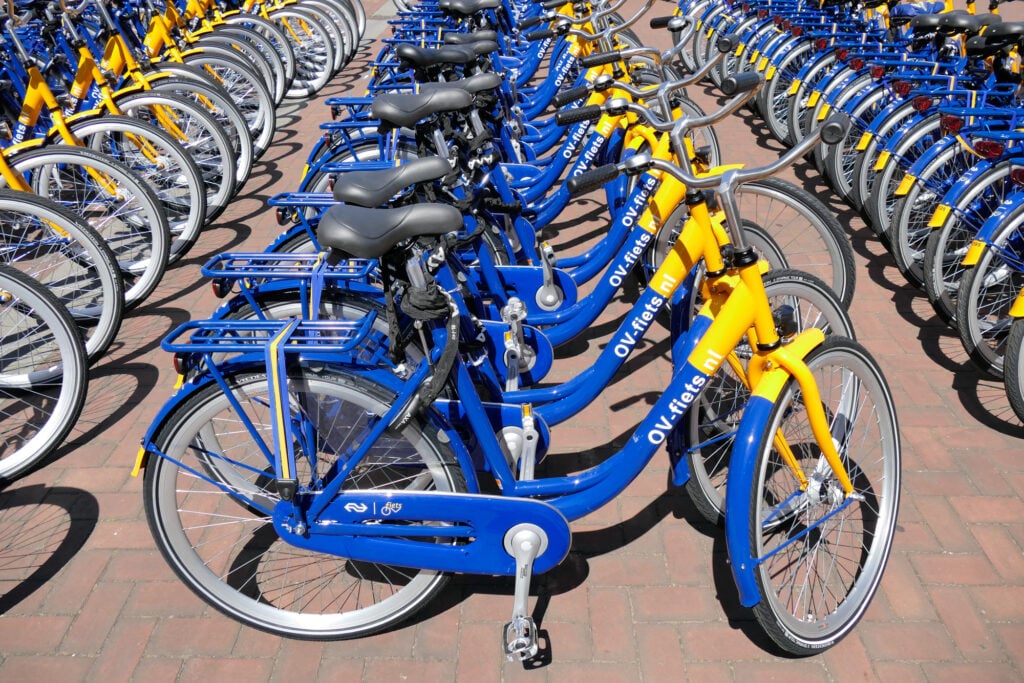
When you’re finished, you can just drop them off at the train station! You can even rent up to two bikes using one OV personal card.
READ MORE | 19 things the Dutch did to make cycling easy and attractive
There are also private bike sharing systems like Donkey Republic that you can make use of.
Taxis in the Netherlands
Taxis are not a particularly common form of transport in the Netherlands (especially if you compare it to London or New York). 🚕
Nonetheless, you can still take taxis here, like if you need to get to the airport at odd hours or if you don’t have a car and it’s faster to drive to your destination.

Instead of hailing a taxi while you’re in the street, you’ll often have to book a taxi in advance through the company’s website.
Warning: Don’t expect taxi services to be cheap. For example, a 20-minute taxi ride can easily run above €50 in a major city. Even booking a taxi in advance costs a lot. A taxi from the Hague to Schiphol airport easily costs €60 for a one-way journey.
You also won’t necessarily see brightly coloured vehicles with a sign that says “taxi” on them — many taxi services have plain, black cars, but others will lean into the stereotypical taxi colour palettes (think bright yellow and orange).
If you’re looking into using a taxi service, you can easily search for your city or destination online and find a taxi company that can take you there!
READ MORE | 11 things to know before taking a taxi in Amsterdam
Ride-shares in the Netherlands
Likewise, ridesharing is an uncommon form of transport in the Netherlands, but companies like Uber offer services in bigger cities.
Similar to taxis, they’re not Dutchies’ first choice of public transport in the Netherlands. They’re more expensive to ride than public transport, and they’re not available in all cities.
Travel tickets and passes for the Netherlands
If you’re only in the Netherlands for a short while, you have plenty of options for buying handy tickets and passes for your travels.
We’ve listed some of the most popular options for when you travel to the Netherlands — but most major Dutch cities will have their own types too.
Holland Travel Ticket
Starting at €70, the Holland Travel Ticket lets you travel on the train, bus, tram, and metro all over the country for one day.
If you travel during off-peak hours (before 6:30 AM, between 9 AM and 4 PM, and after 6:30 PM), the price is reduced to €48!
Amsterdam Travel Ticket
This one-, two-, or three-day ticket is perfect if you’re just hanging out in the city of Amsterdam. You can travel via all major trains, buses, metro, tram, and ferry stations run by GVB.
Do beware, a one-day ticket costs €62.40.
Amsterdam Region and Travel Ticket
This ticket is similar to the Amsterdam Travel Ticket — there’s an option for one, two, or three days, but you can travel in the region around Amsterdam, including Haarlem, Zaandam, Hoofddorp, and Almere.
One-day tickets cost €21, two-day tickets cost €31.50, and three-day tickets cost €40.50.
❓ Public transport in the Netherlands: frequently asked questions
Does the Netherlands run public transport at night?
There are multiple public transport options in the Netherlands that run at night. Several night trains and night buses run in urban areas of the country, so you might be in luck if you miss the last train after a night of drinking and partying!
Public transport in the Netherlands doesn’t run everywhere at night, so it’s important to check with the NS and see which trains are available in your area. For example, some night trains only run on certain days of the week.
Night buses run differently depending on the city you live in, but they only tend to run in big cities with very select stops.
A rule of thumb for these buses and trains is that they usually only run once an hour, but it’s best to check your travel planner to see the exact times and how often they go.
If you’re stuck in an area without night public transport in the Netherlands, helaas! You’ll have to wait until the next morning for the first public transport to run again.
Can you travel internationally on trains in the Netherlands?
Yes, it is possible! For example, you can take a Thalys to Paris, a Eurostar to London, or even an NS International train to Brussels.
If you’re interested in taking one of the international trains, it’s best to look up your desired destination and departure location to see what’s closest, when the trains come and go, and, of course, how much it costs.
How can I plan to ride public transport in the Netherlands?
You can use the 9292 website or app on your phone to plan a journey anywhere using public transport in the Netherlands.
If you just want to travel within a city, you can download the app for that respective city. For example, if you’re planning on using public transport in Amsterdam, you can use the GVB app. Likewise, public transport in Rotterdam is connected to the RET app and The Hague to HTM.
You can also plan train journeys using the NS app (you have no idea how times this app has saved us from disaster!)
Are there timetables for Dutch public transport?
Yes, there are! Typically, public transport in the Netherlands runs from 6 AM until 1 AM. You can access these timetables through a travelling planning app like 9292, NS, or GVB, but you can also check them on the platform/stops themselves.
These displays show you the hourly schedule of the bus/tram/metro that stops there every day of the week!
What time does public transport run in the Netherlands?
In general, public transport in the Netherlands starts running from 6 AM until around 1 AM the next day. For example, you can take the last bus after 12 AM and arrive at your destination before 1 AM.
There are also a few night bus and night train options around larger cities in the Netherlands. To be extra safe, check your public transport apps to see exactly the latest possible time you can leave without missing your train or tram and if there are any night buses or trains you can take.
How can I get discounted public transport tickets in the Netherlands?
Generally, you can get discounted tickets if you travel with a season ticket or during the off-peak hours for public transport in the Netherlands. Off-peak hours are from 9 AM and 4 PM, before 6:30 AM. and after 6:30 PM. On weekends and holidays, off-peak hours apply all day.
Once you’ve read this guide, you’re ready to use public transport in the Netherlands! No delay, transfer, or rush can stop you now.
Do you have any useful Dutch public transport tips? Share them with us in the comments below!






Hi Emma,
My name is Rupali. I am visiting Netherlands with my husband and 11 year old daughter in May 2020.
Let me first congratulate you for your blog….its very informative and nicely written, complete with all the details.
I need help in choosing the perfect travel card for all three of us. I would like to share a small version of my itinerary so you can have an idea.
May 4th–Arriving Ansterdam Central from Brussels–Going to Schagen for one night stay.
May 5th–Cycling to see the Tulip fileds around Schagen. Travelling (by Train/Bus) to Den Helder in the afternoon and from there catch an evening train and head towards Hoorn. Stay at Hoorn.
May 6th–Travel in the steam tram to Medemblik–Ferry to Enkhuizen (tickets booked)
Enkhuizen to Hoorn by train/Bus
Hoorn to Haarlem– by Train; Stay at Haarlem
May 7th–Haarlem—train/bus—Lisse—Visit tulip field—Lisse to The Hague–Madurodam— Haarlem (Train/bus)
May 8th–Haarlem to Amsterdam (train/bus)—Local sight seeing in Amsterdam
May 9th–Haarlem—train -Zwolle –Train/Bus–Emmeloord—train/bus—Giethoorn–Train/bus-return to Haarlem
May 10th–Haarlem to Amsterdam–Rijksmuseum till afternoon
Reach Amsterdam Central– Catch train for Cologne (Germany)(tickets booked).
I was checking the I amsterdam card and OV chipkaart. Which is the most suitable for me?
Purchasing tickets everytime for each and every journey would be little tedious for me. So kindly help.
Sorry for the long message.
Thanks for listening out 🙂
NOTE UPDATE
since at least 2 yrs now if one buys a ticket on buses, trams one MUST pay by CARD and no cash is accepted anymore. Thetrams in AMSterdam, it being the major tourist city have conductors at the back.
In many areas the local regional buses also sell Dagkaarten=daytickets, which are the best way for longer trips or more trips in a single day. The mostly cost around 8-10 eur.
There is also the HTT=Holland Travel Ticket, a daypass for ALL public transportation, train+metro+bus+tram, off peak, valid from 9.00 mo-fr, sat/sun whole day, this cost 42 eur and thus only pays off for longer returns. Buy it from NS-machines.
2023 update: you can now pay using contactless payments on ALL public transport in the Netherlands. This makes it MUCH easier for tourists. Simply use Google Pay, Apple Pay or your contactless bank card to check-in and check-out on each journey. See the ovpay.nl website for more details, and a list of supported debit and creditcards.
Do they take Canadian credit cards?
Pat, all contactless creditcards and debit cards are accepted (both plastic cards and digital cards in your wallet).